How Law Firms Use RAG to Boost Legal Research RAG...
Read MoreSmart Solar Tech: AI Solar Panel Optimization
Table of Contents
ToggleAI is playing an increasingly important role in the development of renewable energy and electricity generation. For example, AI is helping to make solar energy more efficient, reliable, and affordable. As AI technology develops, we can expect to see even more innovative applications of AI in the renewable energy sector.
According to a report by the International Renewable Energy Agency (IRENA), the global market for AI-powered solar systems is expected to reach $12.5 billion by 2028. This represents a CAGR of 22% from 2023 to 2028.
Find out how papAI can improve the deployment of AI projects in the Renewable Energy Industry.
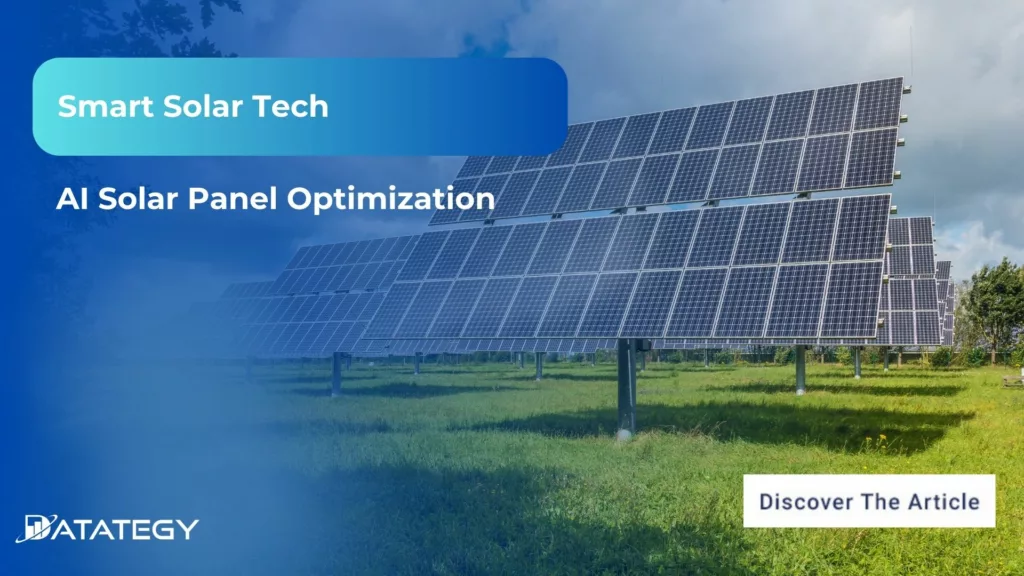
In this article, we’ll look at the benefits and challenges of using AI in the solar industry and how companies can accelerate its adoption.
Overview of Artificial intelligence in Renewable Energy
With a notable CAGR of 27.70% from 2023 to 2032, the worldwide artificial intelligence (AI) in the renewable energy market is predicted to cross USD 114.87 billion by 2032, having been valued at USD 10 billion in 2022.
This increase reflects the growing acceptance and awareness of AI technology in the context of renewable energy. Artificial Intelligence (AI) integration in renewable energy systems is emerging as a major innovation engine in response to the global trend towards sustainable practices. The industry’s response to the pressing demand for more clever and effective ways to utilize renewable resources is shown in this market value’s explosive increase.
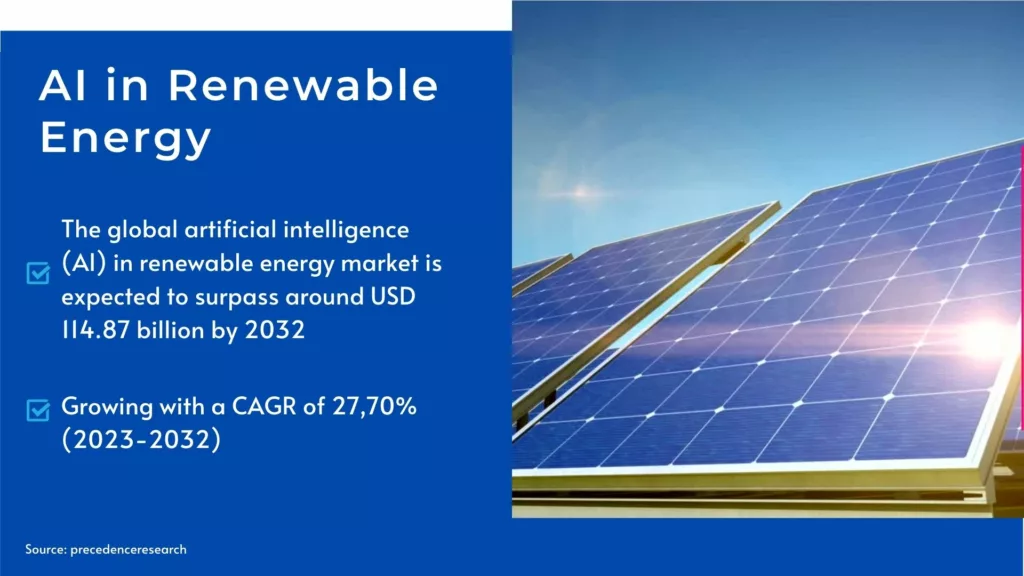
In the recent years, Asia-Pacific held the greatest share of the market. India and other nations in the Asia-Pacific area require adequate power.
The Asia-Pacific region’s renewable energy sector is seeing a spike in artificial intelligence (AI) due to the increased need for power. Furthermore, the existence of significant industry participants engaged in artificial intelligence (AI) within the renewable energy sector is also fostering the expansion of AI within the Asia-Pacific region’s AI market.
North America is anticipated to develop at the quickest rate. The increasing use and acceptance of AI technologies and solutions throughout the energy industry is fueling the rise of artificial intelligence (AI) in the renewable energy market in the North American area.
Another element encouraging the growth of artificial intelligence (AI) in the renewable energy industry in the area is transformation or digitization of the energy sector. Artificial intelligence is also being used to create smart home solutions. This is creating opportunities for artificial intelligence (AI) to grow in North America’s renewable energy business.
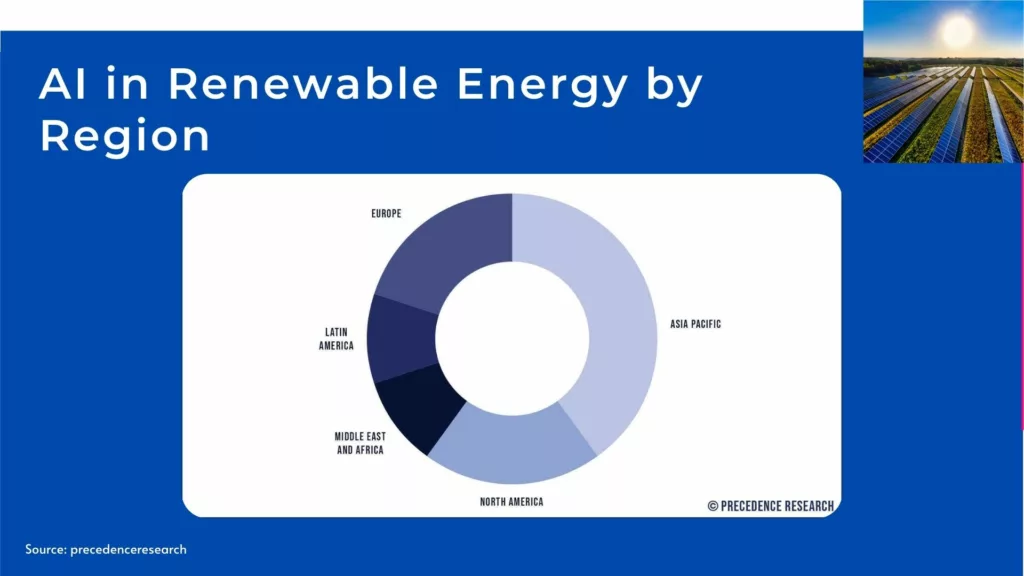
What is a Solar Panel?
A photovoltaic (PV) panel, sometimes referred to as a solar panel, is a device that uses sunlight to generate electricity. It is an essential part of a solar photovoltaic system, which uses solar radiation to create electricity. Solar cells, which are usually comprised of semiconductor materials like silicon, are the building blocks of solar panels.
How does it Work?
Electric current is produced in solar panels when sunlight strikes the semiconductor material that makes up the solar cells. The photovoltaic effect is the term for this process. The electrical energy produced can be stored in batteries for later use or utilized to power a variety of electrical equipment.
The Data's Role for AI Adoption in Smart Solar Tech
Making artificial intelligence technology available to more people than just major organizations or conventional specialists is a key component of democratizing AI. The democratization of data is a crucial component of this process of democratization. A large and varied dataset is necessary for the efficient deployment of machine learning algorithms. A wide range of scenarios must be included in this collection to represent the diversity of real-world applications, user situations, and problems.
Developers may produce machine learning models that are more accurate, reliable, and useful in a variety of contexts by making sure the data is inclusive and representative. In order to lower entry barriers and promote a more inclusive AI ecosystem, open access to datasets, cooperation on data-gathering projects, and open data-sharing procedures are essential.
The AI benefits in Solar Panel Optimization
Empowering Efficiency
Artificial Intelligence (AI) guides the quest to harvest solar energy by optimizing solar panel performance to previously unheard-of heights. Artificial intelligence (AI) algorithms optimize the angle and orientation of solar panels to ensure they collect every ray of sunshine by continuously analyzing environmental parameters, weather patterns, and historical data. By increasing energy output, this greater efficiency moves us one step closer to energy sustainability.
Cost Reduction
AI-driven solar panel optimization has an exponentially positive human impact in addition to its scientific complexity: lower energy bills. With the increasing accessibility of solar technology, communities, and individuals may use AI to optimize the performance of their solar systems, resulting in significant energy bill savings. The democratization of these advantages guarantees that cost savings go to communities, small enterprises, and households equally, rather than only to multinational corporations.
Reliability and Accuracy
Artificial Intelligence (AI) adds a degree of flexibility to solar energy generation, which is sensitive to changes in the environment. Artificial intelligence (AI)–enabled solar panels can adapt to abrupt weather changes by continually learning from real-time data, guaranteeing a steady supply of electricity. This dependability aspect not only adds to uninterrupted energy availability but also mitigates worries about the intermittent nature of renewable energy sources.
How to choose the best AI solution for your data project?
In this comprehensive white paper, we delve into the current landscape of AI solutions available in the market, offering a detailed overview. We go beyond simple exploration, providing concrete guidelines designed to help you select the ideal AI solution.
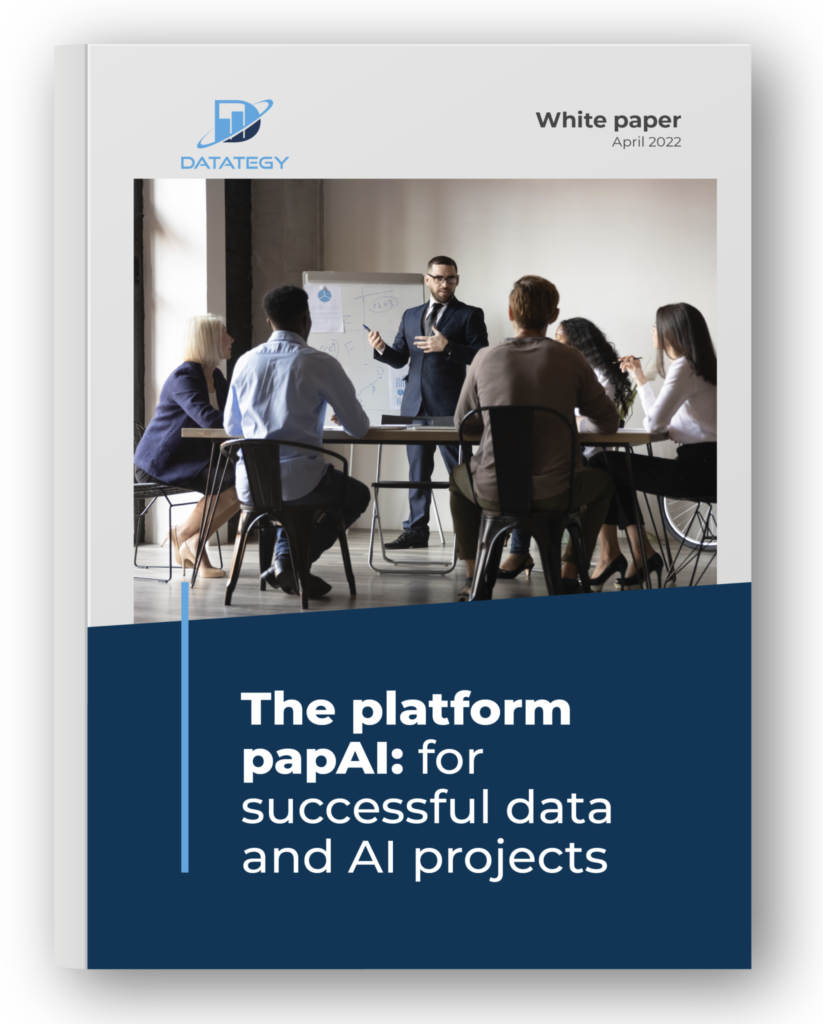
AI Use Cases in the Real World
1- Predictive Maintenance for Solar Panels
AI-powered predictive maintenance has completely changed how solar panel maintenance is done. The system continually monitors many factors, including temperature, voltage, and current, by integrating modern sensors and machine learning algorithms. AI can predict solar panel failures with up to 95% accuracy. (Navigant Research, 2022)
This allows the system to detect possible difficulties before they worsen. By taking a proactive stance, maintenance interventions may be focused, on reducing downtime and guaranteeing peak operating efficiency. Solar panel operators may increase overall system dependability, decrease maintenance costs dramatically, and prolong the life of their equipment by utilizing predictive maintenance.
2- Weather Forecasting for Solar Farms
The use of AI-driven weather forecasting to solar farms is an important advance in the field of solar energy. Suppose that operators of solar farms are guided in maximizing energy output by real-time weather predictions that are rich in useful insights but free of technical jargon.
AI algorithms evaluate a multitude of meteorological data, delivering precise and intelligible forecasts that solar farm operators may rely on for informed decision-making. These projections provide important information about cloud cover, sunshine intensity, and atmospheric conditions in addition to temperature and precipitation.
3- Demande Forecasting Optimization
In the context of solar energy, demand forecasting is a strategic method meant to accurately estimate future power consumption. Demand forecasting examines past consumption trends, present energy usage, and external factors like weather conditions by integrating sophisticated algorithms and data analytics.
This perceptive research makes it easier to create precise forecasts and provides a clear picture of the anticipated future demand for power. These predictions, which are based on real data, enable solar energy systems to anticipate and adjust to changing demand conditions.
One of the most important aspects of optimizing energy output is the flexibility of solar panels to adjust to predicted demand. With accurate forecasts, solar panel systems may dynamically modify their performance to match expected demand trends. For example, solar panels may be adjusted to maximize production at times of high power demand, utilizing peak sunshine hours to fulfill the increased requirements.
4- Remote Management and Control
With the advancement of technology, remote monitoring and control of solar energy systems enables stakeholders to supervise and control solar installations from a distance. This complex program combines cutting-edge management and monitoring features so that users may access and manage solar energy plants from a distance.
Indeed, this implies that solar farms, installations, or even individual panels may be observed in real-time, allowing for quick reactions to operational aspects like weather variations or performance problems. Because professionals can identify and resolve problems quickly without having to visit the location, this degree of remote monitoring expedites maintenance operations.
5- Solar Panel Positioning Optimization
Maximizing energy efficiency in solar systems is largely dependent on optimizing the positioning of solar panels. This procedure is essentially dynamically adjusts the orientation and location of solar panels in order to take advantage of the available sunlight.
Solar panels that are intelligent enough to know how to best line themselves with the path may collect as much sunlight as possible all day long. This optimization is not a static project; rather, it makes quick modifications based on real-time data on seasonal fluctuations, weather patterns, and sunshine intensity.
This degree of flexibility increases the solar panels’ energy production, allowing them to capture as much sunlight as possible and eventually increasing the overall efficiency of solar energy systems.
Overcoming the challenges of AI Adoption
More than ever, it might be challenging to choose the best artificial intelligence solution for your company. How come? Every day, the number of AI platforms that are offered increases. Software is always evolving, giving an increasing number of straightforward and functional functions.
It is a little difficult to navigate. Data initiatives are proliferating concurrently. It’s true that not all businesses make use of the data at their disposal, or find it difficult to obtain it.
Furthermore, AI-based data initiatives don’t always turn out well. There are several reasons for these failures:
Accessibility for business: Few AI solutions are designed for business users. This makes it difficult to share intelligible and usable results with non-specialists.
Collaboration: The solutions on the market do not always offer a collaborative mode to allow data teams to work together on the same projects or to share models to duplicate them for other use cases.
Complexity: AI solutions are not always ergonomic, practical or even user-friendly. This reinforces the image of complexity and reduces user adoption.
Create your Custom AI-based solar energy solution to address your unique needs
With a range of tools and features designed specifically to improve cooperation, papAI Solution is a powerful AI and data science platform. Teams are able to cooperate more effectively because of its project management tools, data sharing and collaboration tools, and communication and collaboration tools. These tools lessen the possibility of disagreements, mistakes, and missing tasks.
1- Powerful Data Management Tools
papAI is a platform that offers robust data management options to businesses so they can handle, store, and analyze massive amounts of data efficiently. Its natural language comprehension enables data scientists to analyze unstructured data, such as text, images, and videos. One of its main attributes is this.
In addition to assessing action performance, papAI offers real-time execution timings for queries, scripts, machine-learning models, and forecasts. In reaction to anomalies or situations, the tool provides the ability to halt or compel the further steps of the processing chain.
It also allows users to mutualize a sub-chain of treatments to many processing chains, assess modifications without affecting production, and use machine learning to automate or propose actions to speed up data preparation.
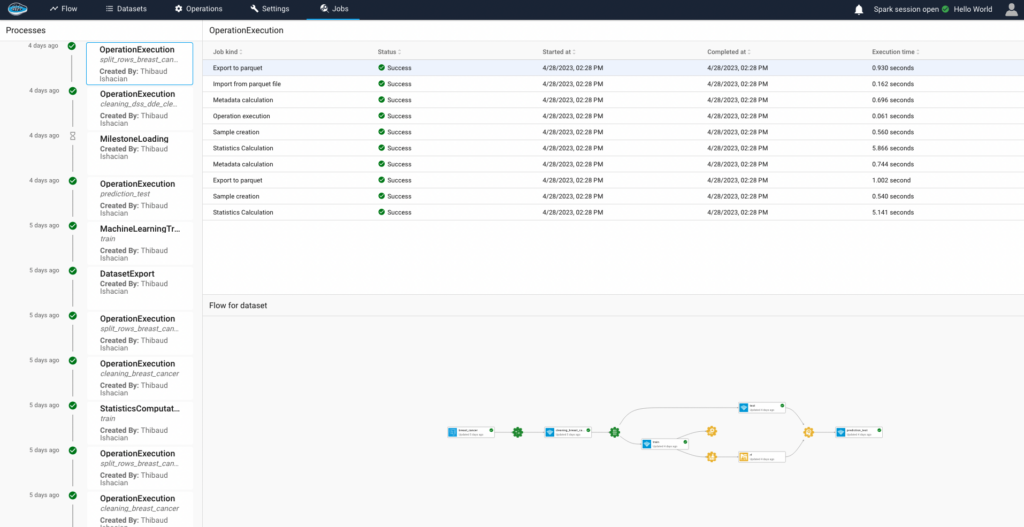
2- MLops as a Service
The papAI solution transforms MLops since it provides a full-service solution. We oversee all facet of machine learning operations, encompassing model deployment, performance tracking, and automated retraining. Our objective is to guarantee that models continually produce reliable forecasts.
Our proactive performance monitoring sets us apart from the competition. We promptly notify the user if the model’s performance falls short of a certain level. We don’t stop there, though.
The papAI cluster may be expanded with ease by users, increasing the potential and use of the system. Because of its dynamic scalability, the solution may expand to meet customer demands.
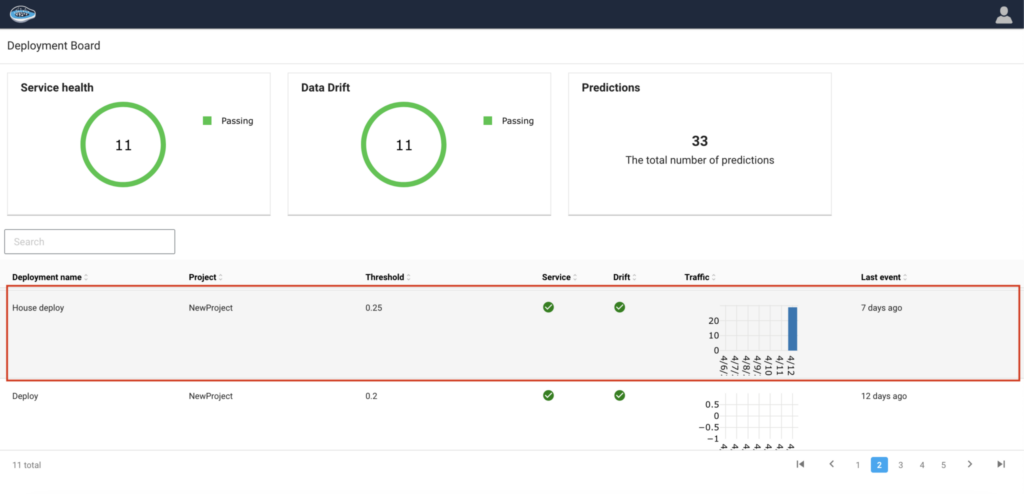
3- Explainability and Interpretability
Explainability is essential for AI and machine learning programs, especially in sectors like energy where the decisions these systems make might have a big impact.
papAI Solution recognizes this and provides a range of explainability capabilities to help teams understand how their models and decision-making procedures operate at their core. Our newest study indicates that over 80% of complicated decisions are obvious because to papAI.
To what extent can anything be explained? The dashboard is one tool that does this by giving a clear overview of the primary elements influencing a model’s judgments. The dashboard offers thorough explanations of how each factor affects a forecast, making it possible for teams to comprehend the reasoning behind the model’s decision-making process.
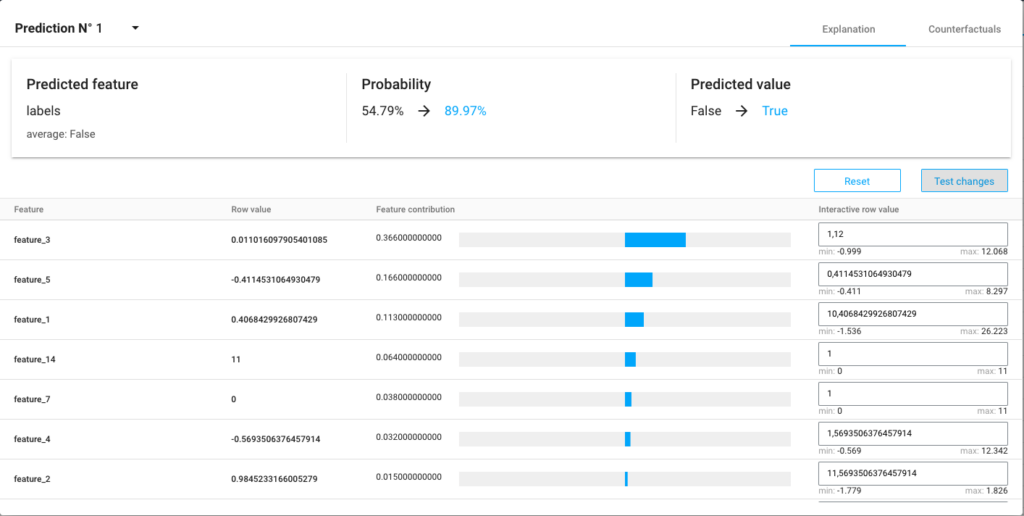
By scheduling your demo right away, you can work with our team of AI specialists to develop a tailored AI solution that will best meet your company’s goals.
A photovoltaic (PV) panel, sometimes referred to as a solar panel, is a device that uses sunlight to generate electricity. It is an essential part of a solar photovoltaic system, which uses solar radiation to create electricity. Solar cells, which are usually comprised of semiconductor materials like silicon, are the building blocks of solar panels.
AI optimizes solar panels, enhancing efficiency, cutting costs, and ensuring reliable energy production with precision.
Predictive maintenance optimizes solar panel performance. Coupled with weather and demand forecasting, remote management, and precise panel positioning, these technologies embody efficiency, reliability, and advanced control, redefining the landscape of solar energy infrastructure.
Interested in discovering papAI?
Our AI expert team is at your disposal for any questions
How RAG Systems Improve Public Sector Management
How RAG Systems Improve Public Sector Management The most important...
Read MoreScaling RAG Systems in Financial Organizations
Scaling RAG Systems in Financial Organizations Artificial intelligence has emerged...
Read MoreHow AgenticAI is Transforming Sales and Marketing Strategies
How AgenticAI is Transforming Sales and Marketing Strategies Agentic AI...
Read More


